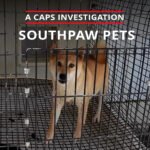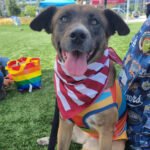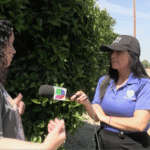Breeder: Kleven, Linda and Craig
City, State Zip: Walnut Grove, MN 56180
Year: 2001
USDA License: 41-A-0015
USDA Inspector: Catherine Hovancsak, VMO
USDA Inspections: Last USDA Inspection Prior to CAPS Investigation: 12/13/00 – “No non-compliances identified this inspection”;USDA Inspection Subsequent to CAPS Investigation: 1/2/02 – One violation
Date of CAPS Investigation: 2001-10-29
Approximately 100 dogs. Breeds included Miniature Pinschers, Shih Tzus, Lhasa Apsos, Pomeranians, Rat Terriers, Jack Russell Terriers, Pekingese, Schnauzers, Corgies, Akitas, Yellow Labradors, Basenjis, West Highland Terriers, Schipperkes, Pugs and Poodles.
The property around the kennel areas was cluttered with weeds and debris (3.11(c)-Housekeeping for premises). The debris included old, cracked plastic dishes, bones, dog fur, chicken feathers, boards, etc. Cats, sickly kittens, chickens and turkeys ran loose on the property. There were chicken and turkey feces all over the yard. However, the area near the Klevens home was very clean and tidy.
The small breed dogs lived in outdoor runs. These runs were made out of chain link fence and concrete with concrete fecal run-off troughs in front. The troughs had a lot of feces and hair build-up (3.1(f)-Drainage and waste disposal) (3.11(a)-Cleaning of primary enclosures). The concrete floors of the kennels were starting to chip and crack (3.4(c)-Outdoor housing facilities, Construction) (3.6(a)(1) and (2)(ix)-Primary enclosures) and had urine and feces stains (3.1(c)(2)(3)-Housing facilities, general; Surfaces) (3.11(a)-Cleaning of primary enclosures). The chain link fencing was rusty in most areas (3.1(c)(1)(i)-Surfaces). This area was hidden behind an old privacy fence.
The dog doors leading into their shelters were chewed and in need of replacement (3.1(c)(2)-Maintenance and replacement of surfaces) (3.4(c)-Outdoor housing facilities, Construction) (3.6(a)(i)-Primary enclosures). Some units were missing entire dog doors 3.1(1)-Structure; construction) (3.6(a)(i)-Primary enclosures) and had scratched wooden openings 3.1(c)(2)-Surfaces) (3.4(b)-Shelter from the elements) (3.4(c)-Construction) (3.6(a)(1)-Primary enclosures).
The Shih Tzus, Poodles and Pekingeses were damp and had obvious urine stains on their fur (2.40-Veterinary care).
The chain link outdoor runs with the larger dogs and small breeds were in far worse condition. These runs had fecal run-off troughs in front of the enclosures with feces, urine and hair build-up (3.1(f)-Drainage and waste disposal) (3.11(a)-Cleaning of primary enclosures).
Dog urine and liquid was running from one kennel into the adjoining pens (3.1(f)-Drainage and waste disposal). Male dogs urinated through the fence onto dogs in adjoining pens. A wheelbarrow brimming with urine, liquid feces, old bones and hair and old dog kibble sat in front of these enclosures (3.1(f)-Drainage and waste disposal). It put off a very foul odor; which was worse than that of the filthy ammonia odor of the enclosures. West Highland Terriers and Shih Tzus in this area were damp and had urine stains on their fur. Some of the kennels had dirty, white plastic water bowls with stagnant green algae (3.10-Watering) (3.11(b)(2)-Sanitization of food and water receptacles. I saw flies and old bones, fur, leaves and other debris in the bowls (3.11(b)(2)). Dog doors were chewed 3.1(c)(2)-Surfaces) (3.4(c)-Outdoor housing facilities, Construction) (3.6(a)(1)-Primary enclosures) and even missing in some enclosures (3.4(b)-Shelter from the elements).
An old male Akita was in need of grooming (2.40-Veterinary care) and his hair was falling out in clumps. His ears had been chewed off and had healed (2.40). The chain link kennel area was severely rusted (3.1(c)(1)(i)-Surfaces) and chewed (3.1(c)(2)-Maintenance and replacement of surfaces). The female yellow Lab in the pen next to the Akita was in heat. The male Lab housed with her would not leave her alone. Her neck was missing fur and had a red sore area (2.40). This may have been caused by her collar.
I did not notice a wind or rain break or shade for the dogs when they were in the outside portion of their enclosures (3.4(b)(2)-Shelter from the elements).
The indoor shelter area for these dogs consisted of poorly constructed dens inside of a large barn. The wood inside of the shelters was unsealed and chewed (3.1(a)-Structure; construction) (3.4(c)-Construction) (3.6(a)(1)-Primary enclosures). I saw no bedding, and the temperature was approximately 35 – 40° F at night and 49° F during the daytime (3.4(b)(4)-Shelter from the elements).
The inside of the barn was littered with debris including unused boards, wire, tractors, large amounts of straw and hay, leaves, electrical cords, gas cans, an air compressor, lawn mowers, etc. (3.11(c)-Housekeeping for premises). Chickens, turkeys, mice, cats and sickly kittens were also in the barn (3.1(b)-Condition and site). The barn had a dirt floor. This area was also used for food storage. Bags of food were stacked on the dirt floor (3.1(e)- Storage of food and bedding). Empty (Diamond) bags were tossed around on the floor (3.1(b)-Condition and site). The empty bags had been chewed by the rodents, and I noticed a sickly kitten napping in one.
The whelping building had a very strong ammonia odor (3.2(b)-Indoor housing facilities, Ventilation). The cages were hutch style and painted white. The floor was made of cracked concrete (3.2(d)-Interior Surfaces) (3.6(a)(2)(x)-Primary enclosures) Underneath the pens was liquid (urine and water) and feces (3.11(a)-Cleaning of primary enclosures). A green garden hose was under the hutches in this wet mess.
I noticed that the dogs had scratched the paint off of the inside walls of their enclosures (3.1(c)(2)-Maintenance and replacement of surfaces (3.6(1)(1)-Primary enclosures). There was a lot of hair build-up in and around the cages (3.2(d)-Interior Surfaces).
In one cage, I saw three very matted, dirty Schnauzers (2.40-Veterinary care). They were in desperate need of grooming and had extremely long toenails. The plastic coating over the wire part of the enclosure was peeling off, leaving rusty wire exposed (3.1(c)(1)(i)-Surfaces) (3.1(c)(2)-Maintenance and replacement of surfaces) (3.6(a)(2)(xii)-Primary enclosures).
The Klevens are also using an old house trailer as a whelping building. I opened the door and was almost knocked out by the strong ammonia odor (3.2(b)-Ventilation). What used to be the living room and kitchen in this old trailer was now used for food storage. Bags of food were tossed around on the floor (3.1(e)-Storage). Unused filthy kennel crates, dirty syringes (2.40), medicine, shredded newspaper, feces and dog kibble littered the floor, tables and counter tops (3.1(b)-Condition and site). The dogs were kept in the back bedrooms. I did not notice proper ventilation (3.2(b)-Ventilation). The floors still had old carpet on them. They were not impervious to moisture (3.2(d)-Interior Surfaces) and looked like they had never been cleaned (3.11(b)(3)-Sanitization of primary enclosures).
Strangely enough, I also noticed Fisher Price toys and children’s riding toys stored in with the dog supplies. It also appeared that there had been a leak in the roof due to the water-damaged walls (3.1(a)-Structure;construction). It is hard to believe that Dr. Hovancsak found no non-compliances at this facility on 12/31/00 and just a 3.4(b)(4) violation for lack of bedding in the outdoor housing facilities on 1/2/02. (See Appendix A-3 for photos of the Kleven facility).




